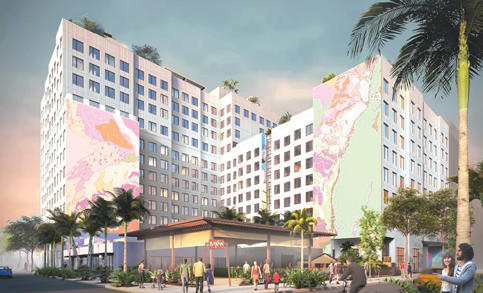Multi-use Wynwood project with hotel wins design OK

A plan to construct a building 12 stories high in Wynwood, bringing residential units, hotel rooms and an internal courtyard with commercial-retail uses, gained a positive vote from the Wynwood Design Review Committee, along with some recommendations.
Developer Wynwood Gateway II LLC proposes to build The Collective Wynwood at 2825 NW Second Ave., providing 143 multi-family residential units, 70 hotel rooms, 9,508 square feet of commercial-retail uses and parking for 175 vehicles, both on-street and an on-site enclosed basement garage.
The building will include an 8-story section and 12-story section, and incorporate a European-style paseo connecting people from Northwest 28th and 29th streets, and from a programmed internal courtyard to Northwest Second Avenue.
Attorney Steven J. Wernick, representing the developer, said the project has been in the works for at least a year and a half, and the developer’s team has met many times with city staff on the design.
“This is what Wynwood is about,” he told the committee.
The L-shaped Collective Wynwood, prepared by Corwil Architects, is planned for the northern gateway to the booming Wynwood Arts District.
In a letter Mr. Wernick wrote: “The Collective has as its core mission to build and activate spaces that foster human connection and enable people to lead more fulfilling lives … The Collective’s projects are rooted in communal space and experience, designed to evolve with the dreams and desires of its members. One of the key benefits for residents that makes The Collective unique and more accessible is the low barrier to entry and duration of stay options.
“Residents enjoy all-inclusive billing, room cleaning, co-working spaces on site, laundry service, gym membership, and cultural events programming that sets it apart from other residential buildings,” he wrote.
Mr. Wernick said The Collective Wynwood is amenity rich, incorporating significant amenity spaces accessible to residents and their guests, including “a 24/7 manned reception and lobby with community activation zones, resident co-working space with bookable meeting rooms, Virtual and Digital games area, physical and analogue games area, library, artist workshop / studio, wellness zone (Spa, gym, exercise studio, swimming pool), community garden, communal F&B dining options, and a myriad of small and large community gathering space. Ample exterior relaxation and lounge spaces are also provided.”
He added that the courtyard atrium creates an opportunity for social interaction, art programming, education, and other moments that bring together both residents and the larger community.
“Thank you for your presentation,” said Committee Chairman Victor Sanchez.
“I appreciate the great imagery and finishes … much appreciated. I also appreciate that you’re engaging an art curator from the beginning. It helps to drive the design,” Mr. Sanchez said.
He continued, “Having said that, my biggest concern is … there’s greater design on the inside, and the outside is mostly monolithic.”
A couple of committee members also expressed concerns about the building’s mass and size. But others commended the developer’s team and designers for a series of what they are calling “crevasses” — color and indentions — in the façade as a way to break up the massing.
The developer expects to request several waivers, including:
■Up to a 30% reduction in required parking near a transit corridor.
■Up to a 10% reduction in drive aisle width.
■Up to 10% reduction in minimum frontage length.
■Up to a 10% increase in maximum floorplate restrictions. The project is proposing a maximum floorplate of 19,800 square feet, where 18,000 is the standard maximum for the zoning.
The committee’s recommendations included: introduce more depth into the ground floor crevasses and add more art to help break up the mass at that level; screen all rooftop equipment; consider different sized windows for the eighth or sixth floor, to break up the verticality.







Recent Comments